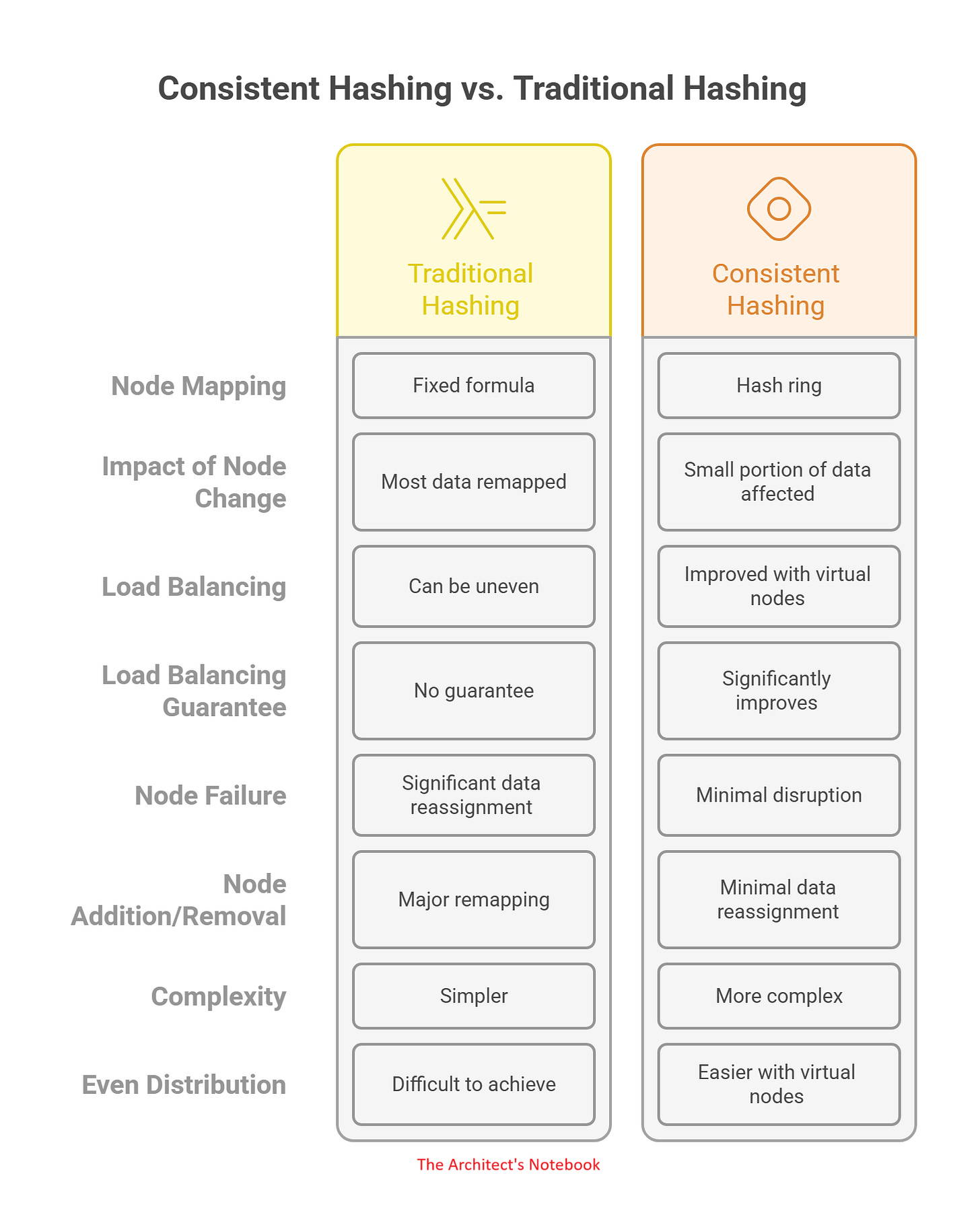Ep #16: Cracking Consistent Hashing: How It Works and Where It's Used
Techniques to evenly distribute data and traffic across nodes.
Ep #16: Breaking the complex System Design Components
⚠️ Note: This is a free preview of a premium post.
You’ll find the first part of the breakdown below — if you’d like to read the full version and get access to all deep-dive system design content, click here to become a member.
I always want to respect your time, so thank you for reading and supporting thoughtful writing.
In Part 1, we explored the pitfalls of traditional hashing and why consistent hashing is crucial for distributed systems. Now, let’s dive deeper into how consistent hashing works, and how systems like Cassandra, Memcached, and CDNs apply it to achieve load balancing and scalability.
How Does Consistent Hashing Work?
Let’s dive into the mechanics of consistent hashing with a simple analogy and a step-by-step explanation.
The Hash Ring Analogy
Imagine a circular ring, like a clock face, where the circumference represents a range of numbers (e.g., 0 to 2³²–1). This is called the hash ring. Both data (or requests) and nodes are placed on this ring based on their hash values. The key idea is to map data to the nearest node on the ring in a consistent way.
Here’s how it works:
Hashing Nodes and Data:
Each node in the system (e.g., a server) is assigned a position on the hash ring based on its hash value. A hash function (e.g., MD5 or SHA-1) takes the node’s identifier (e.g., its IP address) and produces a number that places it on the ring.
Similarly, each piece of data (or request) is hashed using the same hash function, which places it on the ring.
Assigning Data to Nodes:
To assign a piece of data to a node, you find its position on the hash ring and move clockwise (or counterclockwise, depending on the implementation) until you encounter the first node. That node is responsible for the data.
Handling Node Additions and Removals:
When a new node is added, it’s hashed and placed on the ring. Only the data that falls between the new node and the next node in the clockwise direction needs to be reassigned.
When a node is removed, the data it was responsible for is reassigned to the next node in the clockwise direction.
This approach ensures that only a small fraction of data is affected when the system changes, unlike traditional hashing, where most data would need to be remapped.
A Step-by-Step Example
Let’s walk through a practical example:
Initialize the Hash Ring:
Suppose you have three nodes: Node A, Node B, and Node C.
Using a hash function, their positions on the ring are calculated as:
Node A: hash("Node A") = 100
Node B: hash("Node B") = 200
Node C: hash("Node C") = 300
These nodes are placed on the ring at positions 100, 200, and 300.
A Note on What’s Coming Next
Over the past few months, I’ve poured my time, energy, and experience into writing detailed, real-world system design explorations here. Many of you have written to say these deep dives helped you see things differently, get unstuck at work, or even crack interviews—and that means the world to me.
As I continue this journey, I’m introducing a supporter tier—not as a paywall, but as a way to go deeper.
For those who find value in these posts and would like to support this effort, the paid tier will include:
🧠 One premium deep-dive article every week
🎯 Real-world examples from live systems, not just theory
💬 Architect-level interview questions and insights
🛠️ Best practices, hard-earned lessons, and mental models
And more focused content that goes beyond the basics
📥 How to Access Premium Content
👉 Purchase a membership via Gumroad (Silver or Gold Plan)
If your Substack login email is different from the one you used on Gumroad, please send both your Substack and Gumroad email addresses to thearchitectnotebook@gmail.com so I can add you as a paid subscriber.
Once added (you will get a confirmation), you should be able to read all the premium content on Substack itself. If not, then please logout and re-login to your Substack account.
Premium subscribers will also receive each post directly via email, so you don’t miss anything.
💡 Plans:
Silver Plan: $5/month
Gold Plan: $55/year (1 month free)
👉 https://amitraghuvanshi.gumroad.com/l/thearchitectsnotebookI’ll continue publishing free, high-quality content — that won’t change.
But if my writing has added value to your learning, this is a small token of appreciation that helps keep me motivated and allows me to invest more time in crafting content that saves you time and uncertainty in your career.
Thank you for being here, sharing thoughts, and helping this community grow. Let’s keep building together.



